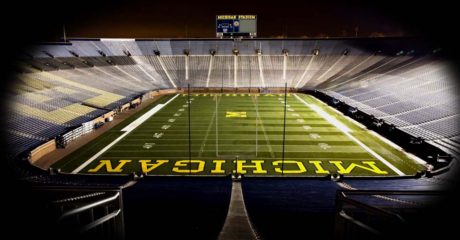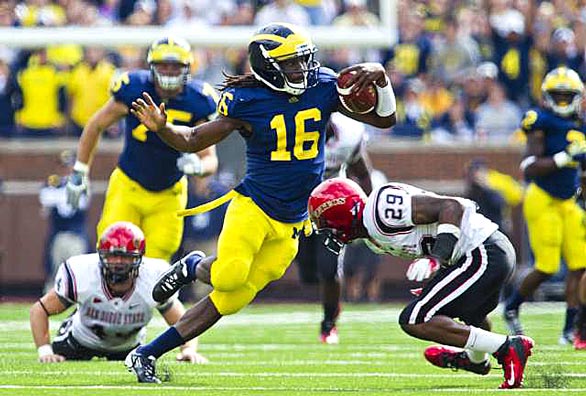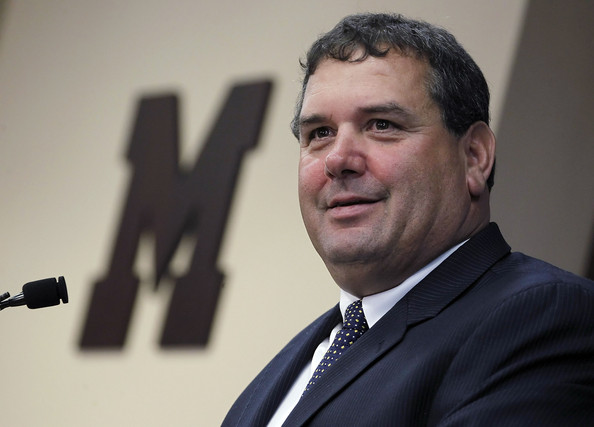

 |
| Denard Robinson had 200 yards rushing in Saturday’s 28-21 victory (image via LA Times) |
What is this “defense” thing everyone keeps talking about? Aside from the Notre Dame game, Michigan has allowed only 6.7 points per game. Admittedly, those other three opponents have been mediocre – two MAC teams and a decent squad from the MWC – but this is still a somewhat impressive turnaround from last year. The Wolverines held San Diego State’s rushing attack to only 4.2 yards per carry and forced quarterback Ryan Lindley into completing fewer than 50% of his passes.
Weekly Denard Robinson blurb. I’m not sure how I feel about Denard Robinson’s play right now. I love the kid for his heart and attitude – and considerable running skills – but something just isn’t clicking. He finished the game 8-for-17 passing with 93 yards, 0 touchdowns, and 2 interceptions. Those numbers are horrible, and that’s the third week in a row that his completion percentage has been lower than 50%. And while it would have been great for Kevin Koger to grab that pass that hit him right in the stomach, the bottom line is that Robinson is extremely inaccurate and making bad decisions. He threw one pass into double coverage that had no business being thrown, and the other he threw the other pick to a blanketed receiver. If Michigan keeps winning, then it doesn’t really matter what his completion percentage is. But if his inaccuracy bites the Wolverines in the butt at any point – and it probably will – then you can bet that some members of the Michigan fan base and the media will start wondering if Devin Gardner should get a shot at quarterback and if Robinson should move to running back. On top of the scattershot arm, it seems to me that Robinson looks a bit slower this year than he did last season. Perhaps he’s worn down or defenses are faster this year; I know he had a 53-yard touchdown run and 200 yards rushing overall, but something seems different.
Craig Roh reads Touch the Banner. Having been spurred on by my call for him to be relegated to a backup role a couple weeks ago, Roh has since responded with two solid games. This week he had 2 tackles; one was a short yardage stuff of running back Ronnie Hillman, and the other was a sack of Lindley on which Roh forced a fumble. It’s slightly disappointing that Michigan could only manage one sack on 48 attempts, but it seemed like San Diego State started taking shorter drops and getting the ball out quicker as the game wore on.
Running back argh. First, I would like to say that I thought Vincent Smith (9 carries, 49 yards, 1 TD) had his best day running the ball at Michigan – except for the fumble. I know he’s had better games statistically (118 yards vs. Eastern Michigan last week, 166 yards against Delaware State in 2009), but those were into gaping holes. Smith actually took short gains and turned them into long gains or a touchdown this week. Hooray for him. Fitzgerald Toussaint had a solid day, too (13 carries, 67 yards). But dammit, I’m going to start beating the Michael Cox drum again. Stephen Hopkins is my new whipping boy. Hopkins needs to sit his butt on the bench and not see the light of day unless he’s a lead blocker or running down the field on special teams or something. Not only is he slow, but he fumbles. In six carries this season, he has fumbled twice; in 43 career carries, he has fumbled three times. If you’re going to be a fumbler, you should at least offer a little bit of reward for the risk; he’s averaging 3.9 yards a carry in his career. Fine, Toussaint and Smith are the top two backs, whatever. But if you’re going to give a third guy a carry, for God’s sake let it be Cox (8.9 yards a carry) or Michael Shaw (5.2).
Jake Ryan is a dreamboat. That dude is just a playmaker. He’s always around the ball and always making things happen. Going back to the spring when he had a sack and an interception returned for a touchdown, Ryan has been a stud. In four games this season, he has 13 tackles, 3 tackles for loss, 2 fumble recoveries, and forced the interception that Brandon Herron returned 94 yards for a touchdown against Western Michigan; he almost had a third fumble recovery on Saturday, but Thomas Gordon beat him to it by a fraction of a second. Ryan still does some fundamental things wrong, but this kid looks like a future star. Also, he has pretty hair that the ladies surely love.
Speaking of future stars. Blake Countess got a lot of run on Saturday, and he looked more than capable. San Diego State started picking on him, and Countess responded with 7 tackles and a pass breakup. The true freshman cornerback was in good position most of the time, and when he was beaten, it was on pinpoint throws by a fifth year senior quarterback. While I hope that starter Troy Woolfolk can return soon after aggravating his sprained ankle, it looks like Michigan has a capable backup if Woolfolk needs to sit out next week.
On SDSU’s list of things to review this week: option responsibilities. Seriously, three dudes jump the pitch man, and nobody accounts for the quarterback?
Congratulations to Brady Hoke. I know it must be tough to coach against the kids he coached last year and the coaches he worked with last season, but it was classy all around – except for the words of former SDSU lineman Kyle Turley, who is a certified douche. San Diego State’s head coach Rocky Long had nothing but good things to say about Hoke. I don’t have any statistics to back this up, but I imagine it’s pretty rare for a college head coach to take another head coaching job . . . and then play his old team the following year.
When I get old, I want to look like Greg Mattison. He’s still all barrel chested and stuff. He must eat his spinach. That dude still looks like he could wrestle a bear. And my money’s not on the bear.
 |
| Brady Hoke says “tough” too much. Whatever that means. |
I try not to turn my blog into one of those that calls out competing* blogs in order to establish some sort of superiority. Because, after all, the blogosphere has been kind to me. The guys at Maize ‘n’ Brew asked me to join them, MGoBlog and The Wolverine Blog link to my site on occasion, etc. My blog is mostly for my pleasure, not because I want to get rich or win any awards.
But Brian over at MGoBlog wrote a post today that bugged me a bit, so I’m responding at length. He takes issue with Brady Hoke’s comments about running the “power play” and makes tongue-in-cheek comments about “manball” and “toughness.” I just don’t see the point.
Brian says:
There are consistent reports that Hoke makes condescending comments about the spread at alumni events. Manball? Manball.
He then goes on to suggest that all people who agree with Hoke’s offensive and verbal philosophies are old, mustachioed, and averse to change.
Well . . . okay. So what? Football’s rules have largely been the same since the forward pass was legalized. Eleven guys on the field, four downs to get ten yards, etc. The emergence of the single wing offense in recent years blew people’s minds. How can you have a running back taking snaps and gaining yards?!?!?! Well, it’s because football is football. Blockers need to block, runners need to run, receivers need to catch, tacklers need to tackle. People didn’t figure out how to stop the single wing before it disappeared around the time of Al Capone. It just got boring. So teams started running the wishbone triple option. Then they started running I-formation plays. Then they took out the fullback and created the run-n-shoot. Then they put the quarterback in the shotgun formation and gave him five wide receivers.
What’s the common theme? All of them work. You know, if they’re run well. Paul Johnson is making the triple option work at Georgia Tech, Chip Kelly runs the spread-n-shred at Oregon, and Bret Bielema scored 83 points in one game using good ol’ fashioned power running at Wisconsin.
It seems Brian is infuriated that Hoke would be audacious enough to speak condescendingly about the spread (and zone blocking in particular), but this is what coaches do. Bo Schembechler liked to run the ball and never shied away from his disdain for throwing the ball. But his teams ran the ball well, so it was okay. Mike Leach threw the ball all over the place at Oklahoma and Texas Tech and thinks throwing the ball gives him an advantage over teams that run the ball more. It works. Why does it matter? If Brian were asked, I bet he could completely eviscerate other successful blogs. He could find fault with their advertising, their commenting formats, their content, etc. In fact, he does this type of thing quite often, at least as far as content goes. He thinks his blog is superior to others. If he didn’t, he would change. And that’s fine. But if those blogs are gaining readership and making money, then it’s all just useless babble.
Of course, much of his stance is based on the fact that Denard Robinson, a Dodge Viper in a Jeep Wrangler world, is Michigan’s quarterback. Robinson possesses the talent to be perhaps the most electrifying spread option quarterback in the history of the game (however short the history of the spread option is), but now he’ll be playing under a coach who eschews zone blocking and likes fullbacks. And it’s true that Robinson was a Heisman frontunner at one point in 2010, a record-breaking signal caller who took the country by storm with his speed, elusiveness, smile, dreadlocks, and failure to tie his shoes. That’s not something that should be completely dismissed.
But when it comes down to it, a coach has to meld a player and a system together. He shouldn’t change the system to fit a player, and he shouldn’t abandon a talented player just because the player isn’t an ideal fit.
Hoke said . . .
Once we get the power play down, then we’ll go to the next phase. You know, because we’re gonna run the power play.
. . .which makes Brian unhappy. He talks about how Michigan has athletic linemen and a tiny starting running back (Vincent Smith), which doesn’t exactly make you think “power run.” Power plays are usually left to mammoth offensive linemen, battering-ram fullbacks, and tailbacks with thighs like tree trunks.
Except Michigan’s offensive line was already inching its way toward 300 pounds across the board, Hoke ran plenty of split back sets in 2010 at San Diego State, and running backs coach Fred Jackson has essentially said, “Vincent Smith will probably not be our starter in 2011.”
The power is the base play of Brady Hoke’s philosophy. Just like any intelligent person wouldn’t have expected Rich Rodriguez to run many powers and whams from the I-formation in 2008, Brian shouldn’t expect Hoke to run loads of quarterback iso’s and and zone stretches in 2011. That’s not Hoke’s game, or Borges’s. Rodriguez ran the zone read option with two stiffs at quarterback, Nick Sheridan and Steve Threet. They were game stiffs, but they shouldn’t have been in an offense that required them to run so much. Michigan won three games. Put those guys in a pro-style offense, and I bet they would have won . . . four (the same three plus Toledo). The difference is minuscule. Meanwhile, those running backs, linemen, and receivers gained experience that allowed them to improve in 2009 and then 2010. The growth of David Molk and Martavious Odoms, for example, would have been stunted if they had to play in a pro-style offense that first year. Molk wouldn’t have had practice with the timing and accuracy of those shotgun snaps, and Odoms might have spent the year sitting on the bench. After all, who needs a 5’9″ freshman receiver when you’ve got a two-back, I-formation base set?
And why wouldn’t the power play be the first thing for Michigan’s players to learn? You don’t hire Rich Rodriguez to run the counter trey, you don’t hire Mark McGwire to teach your hitters how to bunt for a single, and you don’t hire Christina Aguilera to teach you the National Anthem.
10. I-formation, three-wide – Power run
11. I-formation – Play action pass
12. Shotgun, three-wide – Pass
13. Split backs – Power run
14. Shotgun, split backs – Screen pass
15. Shotgun, three-wide – Pass
16. Shotgun, three-wide – Zone read option
17. I-formation – Power run
18. Shotgun, three-wide – Pass
19. I-formation – Play action pass
20. Single back, three-wide – Pass
21. Shotgun, three-wide – Pass
22. I-formation – Play action pass
23. I-formation – Power run
24. Shotgun, three-wide – Pass
25. Split backs – Pass
26. I-formation – Naked bootleg pass
27. I-formation – Draw
28. Shotgun, three-wide – Draw
29. Shotgun, four-wide – Pass
30. I-formation – Play action pass
31. I-formation – Iso run
32. Shotgun, split backs – Pass
33. Single back, three-wide – Pass
34. I-formation (on the goal line) – Power run
35. Single back – Dive
36. I-formation – Play action pass
37. I-formation – Zone run
38. I-formation – Play action pass
39. Shotgun, three-wide – Screen pass
40. Split backs – Power run
41. I-formation – Play action pass
42. Split backs – Screen pass
43. I-formation – Pass
44. Split backs – Dive
45. Shotgun, four-wide – Rollout pass
46. Shotgun, four-wide – Pass
I’m using “power run” a little loosely because I don’t want to break down every play – this isn’t a UFR – but the strategy of using a fullback and a pulling lineman is there. Fifteen of those plays (or about 33%) are either based on power running or, in the case of play action, the threat of the power run. These numbers are only based on one game against a very good team, which SDSU trailed for most of the time. But when roughly one-third of a coach’s offense is rooted in a single series of plays, you can’t just scrap the whole thing.
I think the mindset regarding Denard has morphed into “Give him the ball every play and don’t let anyone else mess it up.” Which is fine until your quarterback carries the ball almost 300 times in one season and misses time in ten out of twelve games due to injury. As we saw this past season, the threat of Denard Robinson running the ball was practically just as dangerous as him actually running it. There were all kinds of examples of wide open receivers running free because Denard took a single step toward the line of scrimmage.
There are multiple ways to use his speed, not just as a 300-carry feature back. He can run the naked bootleg (seen in the above playlist), he can sprint out from the shotgun (seen in the above playlist), he can run a quarterback draw (not seen above, but SDSU’s quarterback was s….l….o….w), etc. Run a play action bootleg and see what defensive end or outside linebacker can handle him out on the edge. It won’t look the same as last year, but it can be effective.
Brian also complains about Hoke’s frequent use of some form of the word “toughness.” I agree that it’s a platitude, but welcome to coachspeak. Find me a coach who doesn’t use the word “tough” more often than a Ford commercial, I dare you.
Furthermore, watch Michigan’s team in 2010. Third-and-short on offense? Michigan can’t line up and run the ball. Third-and-short (or third-and-medium, or third-and-long, third-and-a-parsec)? Michigan can’t get a stop. Need a broken tackle? You won’t get it from Shaw or Smith. Need a tackler to stop someone in his tracks? If it’s not Jordan Kovacs, it’s probably not happening. I won’t question any individual player’s toughness, but the team as a whole could use an injection of it. All coaches preach toughness, but if it takes Brady Hoke repeating the word “tough” until his face turns blue to get his team to actually play like it, then I’m fine with it.
Conclusions and predictions:
*I don’t know what else to call them, but we all know they’re more popular blogs than mine.